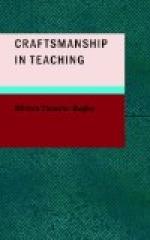And so I maintain that every teacher has a right to know what he is to be held responsible for, what is expected of him, and that this information be just as definite and unequivocal as it can be made. It is under the stress of definite responsibility that growth is most rapid and certain. The more uncertain and intangible the end to be gained, the less keenly will one feel the responsibility for gaining that end. Unhappily we cannot say to a teacher: “Here is a message. Take it to Garcia. Bring the answer.” But we may make our work far more definite and tangible than it is now. The courses of study are becoming more and more explicit each year. Vague and general prescriptions are giving place to definite and specific prescriptions. The teachers know what they are expected to do, and knowing this, they have some measure for testing the efficiency of their own efforts.
III
But to make more definite requirements is, after all, only the first step in improving efficiency. It is not sufficient that one know what results are wanted; one must also know how these results may be obtained. Improvement in method means improvement in efficiency, and a crying need in education to-day is a scientific investigation of methods of teaching. Teachers should be made acquainted with the methods that are most economical and efficient. As a matter of fact, whatever is done in that direction at the present time must be almost entirely confined to suggestions and hints.
Our discussions of methods of teaching may be divided into three classes: (1) Dogmatic assertions that such and such a method is right and that all others are wrong—assertions based entirely upon a priori reasoning. For example, the assertion that children must never be permitted to learn their lessons “by heart” is based upon the general principle that words are only symbols of ideas and that, if one has ideas, one can find words of his own in which to formulate them. (2) A second class of discussions of method comprises descriptions of devices that have proved successful in certain instances and with certain teachers. (3) Of a third class of discussions there are very few representative examples. I refer to methods that have been established on the basis of experiments in which irrelevant factors have been eliminated. In fact, I know of no clearly




